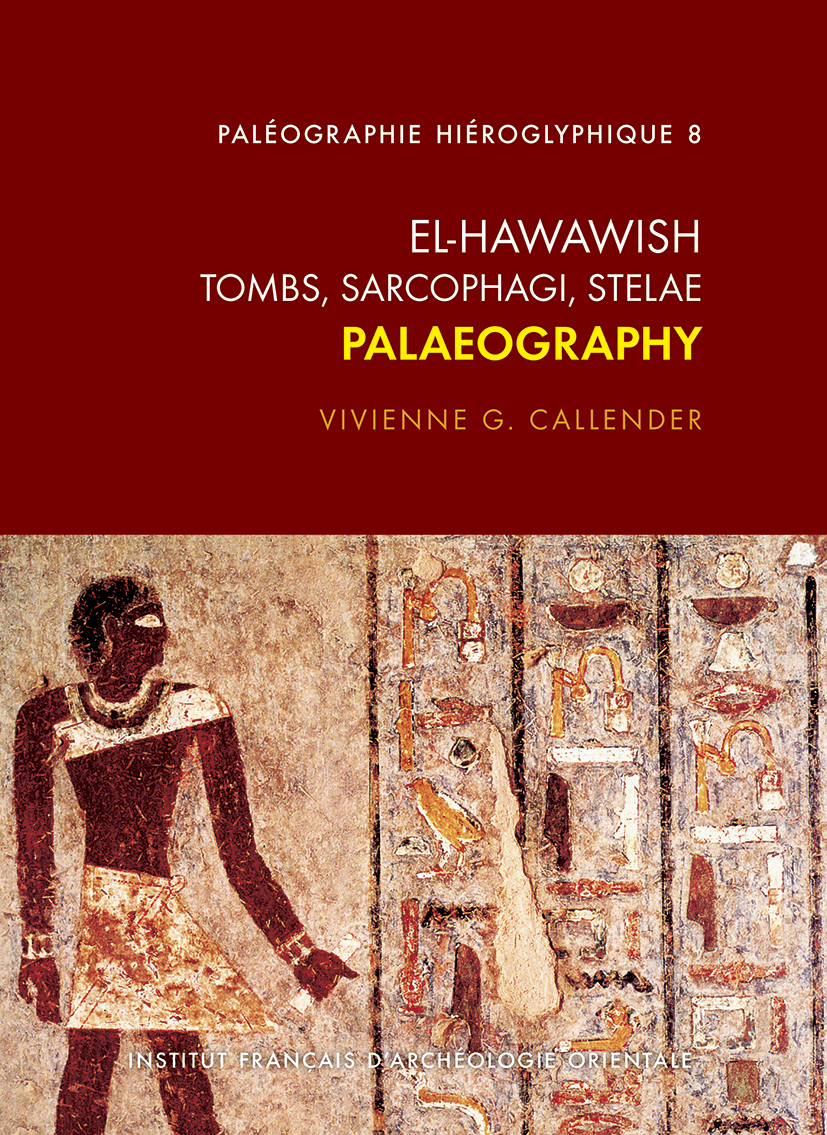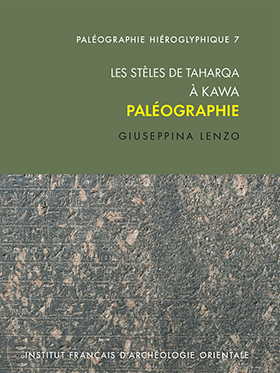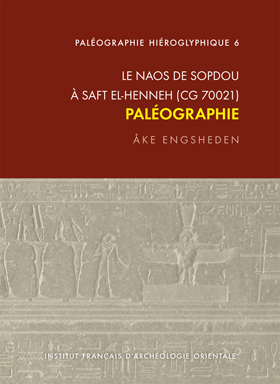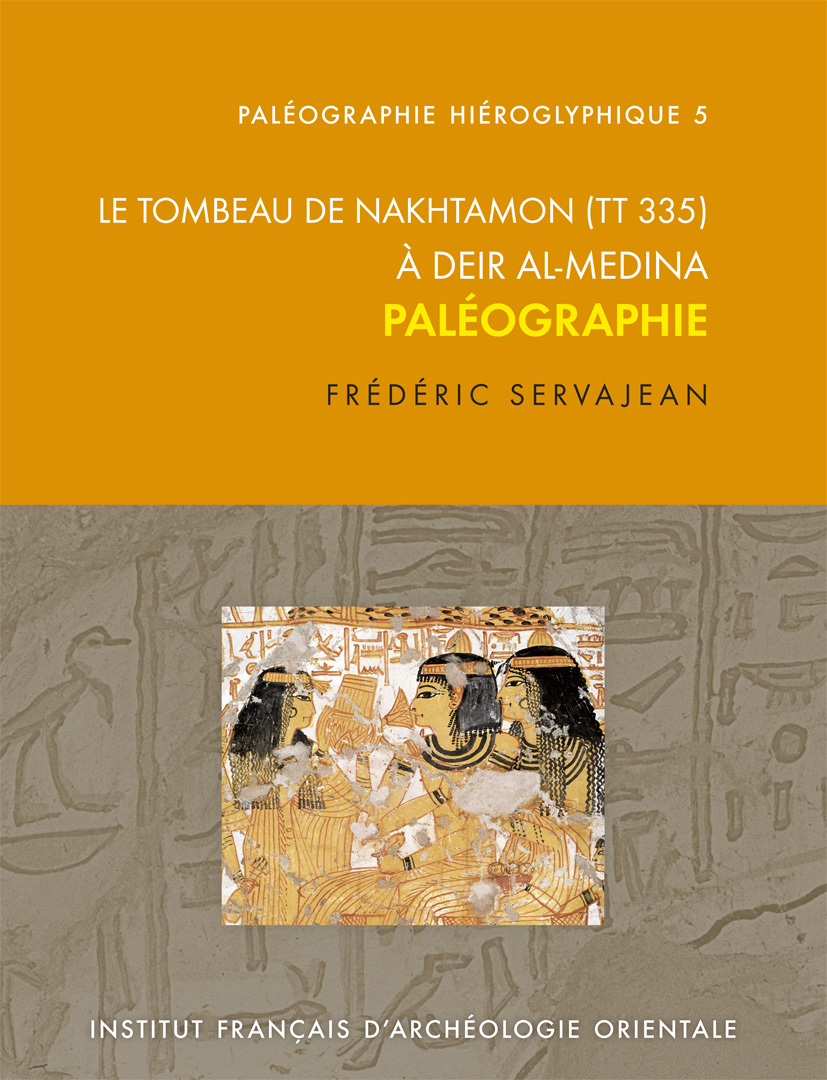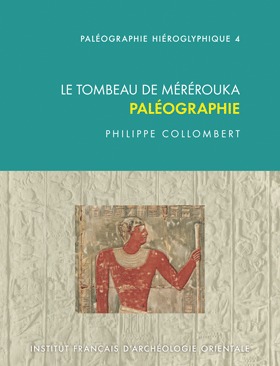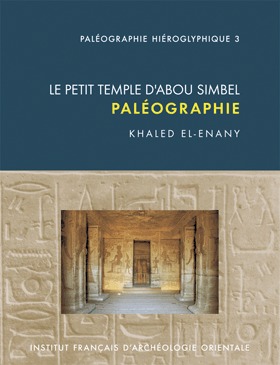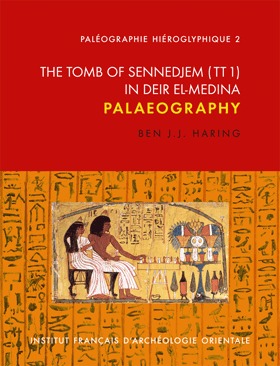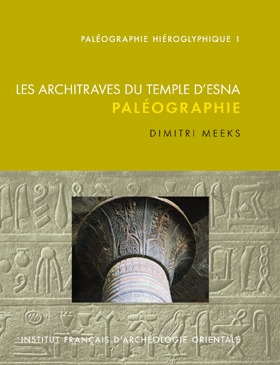Catalogue des publications
- Pour effectuer une commande, remplissez votre panier puis terminez votre commande. Vous pourrez effectuer un paiement sécurisé et être livré dans le monde entier. J’ai un code promotionnel
- To perform an order, fill your cart then proceed the order. You will be driven to a secured page for the electronic payment which includes worldwide shipping fees. I have a promotional code.
Paléographie hiéroglyphique (PalHiero)
Conduite sous la direction de Dimitri Meeks, la collection Paléographie hiéroglyphique (PalHiero) est consacrée à l’étude des formes et des emplois des hiéroglyphes considérés dans leurs variantes typologiques et leur évolution. Chaque volume s’intéresse à un édifice particulier ou un groupe homogène de monuments. L’objectif de la collection est de couvrir l’ensemble de l’histoire de l’écriture hiéroglyphique par l’analyse exhaustive de témoins représentatifs.
ISBN 9782724707311
2019 IFAO
Collection: PalHiero 8
Langue(s): anglais
1 vol. 644 p.
64 € (3200 EGP)
Vivienne G. Callender
El-Hawawish. Tombs, Sarcophagi, Stelae
This present study in the series Paléographie hiéroglyphique offers a segment of hieroglyphic writing from a discrete period: the disturbed times from the end of the Old Kingdom to the end of the First Intermediate Period. Unlike other volumes in this series, however, the hieroglyphs from the Akhmim cemetery of El-Hawawish have been drawn from various sources: tomb reliefs and paintings, stelae, wooden coffins and statues; consequently, both the length of the era and the varied nature of the writing surfaces and the materials used at times encouraged the introduction of numerous and interesting variations into Egypt’s hieroglyphic corpus. The Australian publication of this hieroglyphic record from El-Hawawish has been especially important because of the poor state of preservation of the tombs and the limited printed material available prior to the 1980s. The original documentation was carried out by volunteer students from the universities of Auckland (New Zealand) and Macquarie (Australia), under the inspiration and guidance of Professor Naguib Kanawati. Particularly notable are the careful transcriptions from the wooden coffins from this era, revealing a most inventive and sophisticated approach to writing so many thousands of years ago. Without the dedicated work of those numerous modern hands, the El-Hawawish hieroglyphic corpus would have been lost forever. This volume presents a representative sample of that precious writing. Vivienne Gae Callender is a specialist in Egyptian social history. She is a graduate of New England and Macquarie Universities in Australia. She is an honorary member of the Czech Institute of Egyptology at the Charles University in Prague and for many years has been a member of the Czech team excavating at Abusir in Egypt. She has edited and contributed to various excavation publications, and published many articles and monographs of her own, such as In Hathor’s Image: The Wives and Mothers of Egyptian Kings from Dynasties I-VI (Prague, 2011).
- Vivienne G. Callender (
: 145577988)
Spécialiste de l’histoire sociale de l’Égypte ancienne, elle est membre d’honneur de l’Institut tchèque d’égyptologie de l’université Charles de Prague, et a fait partie de l’équipe tchèque de fouilles sur le site d’Abousir pendant de nombreuses années. Elle a édité ou contribué à de multiples publications archéologiques, et est l’auteur d’un grand nombre d’articles et ouvrages, parmi lesquels "In Hathor’s Image: The Wives and Mothers of Egyptian Kings from Egyptian Kings from Dynasties I-VI" (Prague, 2011).
ISBN 9782724706765
2016 IFAO
Collection: PalHiero 7
Langue(s): français
1 vol. 352 p.
37 € (1850 EGP)
Giuseppina Lenzo
Les stèles de Taharqa à Kawa
This volume of the Paléographie hiéroglyphique collection offers a study of the hieroglyphic signs carved on several stelae of the Kushite King Taharqa of the 25th Dynasty. Among these stelae, five are from the site of Kawa, Sudan. The text of the stela Kawa V about the flood of the Nile in the Year 6 has also been copied on three other stelae found in different locations of the Egyptian territory, which allowed the selection of signs carved in the Delta (Tanis), in Upper Egypt (Coptos and Matâanah) as well as in Sudan (Kawa). Ultimately, eight stelae dating from a period of nine years (689-681 BC) furnished the 439 signs commented in this volume and offered as facsimiles in 118 plates. The signs have been mainly compared with those of monuments and stelae of the Napatan period, but also with those of anterior and posterior periods when that seemed pertinent.
- Giuseppina Lenzo (
: 120620049)
Giuseppina Lenzo est maître d’enseignement et de recherche en religion de l’Égypte ancienne à la Faculté de théologie et de sciences des religions de l’Université de Lausanne. Elle est titulaire d’un doctorat en égyptologie (Université de Genève) et d’une Habilitation à diriger des recherches en Sciences religieuses (EPHE, Paris). Elle travaille notamment sur les textes funéraires de la Troisième Période intermédiaire.
ISBN 9782724706475
2014 IFAO
Collection: PalHiero 6
Langue(s): français
1 vol. 280 p.
45 € (2250 EGP)
Åke Engsheden
Le naos de Sopdou à Saft el-Henneh (CG 70021)
The present work examines the form and function of hieroglyphic signs on the naos of Sopdu from Saft el-Henneh, now in the Egyptian Museum in Cairo. This monument, dating to the 30th Dynasty and inscribed on all four sides, is of considerable epigraphic interest, as there are few similarly long inscriptions from that period. The plates show almost 1,500 signs that have been drawn specially to accompany this publication. These are grouped into 443 categories which are described in the usual format of the collection Paléographie hiéroglyphique: identification of the sign, palaeographical description with particular reference to parallels on contemporary monuments, and function. This volume on the naos of Sopdu is likewise of interest for anyone involved in the study of Egyptian art and religion in the Late Period.
- Åke Engsheden (
: 146222121)
ISBN 9782724705904
2011 IFAO
Collection: PalHiero 5
Langue(s): français
1 vol. 253 p.
39 € (1950 EGP)
Frédéric Servajean
Le tombeau de Nakhtamon (TT 335) à Deir al-Medina. Paléographie
Ce cinquième volume de la collection « Paléographie hiéroglyphique » est consacré à la tombe de Nakhtamon à Deir al-Medina (XIXᵉ dynastie). Il étudie les 261 signes hiéroglyphiques recensés dans ce monument. Le commentaire paléographique décrit chaque signe en établissant une corrélation avec les sources contemporaines, mais aussi avec l'utilisation qui en est faite dans des monuments plus anciens. Le livre est illustré par une sélection des fac-similés caractéristiques des signes étudiés ainsi que par dix-neuf planches réunissant les photographies de l'ensemble de ces hiéroglyphes.
The fifth volume of the collection "Paléographie hiéroglyphique" is dedicated to the tomb of Nakhtamun at Deir al-Medina (19th Dynasty). It examines the 261 hieroglyphic signs found in this monument. The palaeographical part deals with the commentary of each sign in relation with contemporary sources as well as monuments of early periods. The book is illustrated by a selection of characteristic drawings of the various identified hieroglyphs and by nineteen photographical places of these signs.
- Frédéric Servajean (
: 074002937)
ISBN 9782724705706
2010 IFAO
Collection: PalHiero 4
Langue(s): français
1 vol. 310 p.
54 € (2700 EGP)
Philippe Collombert
Le tombeau de Mérérouka. Paléographie
Consacré au mastaba de Mérérouka (début de la VIᵉ dynastie), ce nouveau volume de la collection « Paléographie hiéroglyphique » étudie les 356 signes hiéroglyphiques gravés (et parfois peints) relevés dans la tombe. Le commentaire paléographique définit la nature de chacun, s'intéresse aux variantes connues dans les sources contemporaines et en détaille les différents emplois, tant dans ce monument que dans d'autres. Le tout est illustré par 108 planches réalisées à partir de la publication du mastaba par l'Oriental Institute de Chicago, présentant une sélection de dessins caractéristiques des différents hiéroglyphes recensés.
>> Lire l'introduction.pdf (0.32 Mb)
This new volume in the collection "Paléographie hiéroglyphique" is dedicated to the mastaba of Mereruka (early 6th Dynasty). It examines the 356 hieroglyphic signs carved (and sometimes painted) found in the tomb. The palaeographical commentary defines the nature of each sign considering the other variants in the contemporary sources and details their different uses in this monument as well as in others. The book is illustrated by 108 plates based on the publication of the mastaba by the Oriental Institute of Chicago, presenting a selection of characteristic drawings of the various hieroglyphs identified.
- Philippe Collombert (
: 149147546)
Philippe Collombert, égyptologue, ancien membre scientifique de l’Ifao, est actuellement professeur ordinaire à l’Université de Genève. Il est directeur de la Mission archéologique française de Saqqâra (fouilles de la nécropole de Pépi Ier).
Khaled el-Enany
Le petit temple d'Abou Simbel. Paléographie
- Khaled el-Enany (
: 079118437)
ISBN 9782724704334
2007 IFAO
Collection: PalHiero 2
Langue(s): anglais
1 vol. 230 p.
45 € (2250 EGP)
Ben J. J. Haring
The Tomb of Sennedjem (TT1) in Deir El-Medina. Palaeography
Although of modest proportions, the burial chamber of TT 1 is decorated with many exquisite scenes, and with a wealth of inscriptions in painted hieroglyphs. These hieroglyphs are the subject of the present volume, which aims to classify, describe and explain the individual signs and their forms. The series Paléographie hiéroglyphique covers the entire period during which hieroglyphic texts were made, from the Old Kingdom to the Graeco-Roman Period. As a part of the series, this book is illustrative of a particular stage in the graphic and functional development of hieroglyphs: painted monochrome hieroglyphs in private tombs of the early Ramesside Period. The use and graphic variety of every individual sign is discussed in the commentary, and represented by samples in the palaeographical tables. A general commentary deals with the technique of painting the signs, their relation to other Pharaonic Egyptian scripts, the all-important influence of orientation on the shapes of hieroglyphs, and the mistakes and corrections made by their painter. Finally, a comparison is made between the signs in TT 1 and other tombs at Deir el-Medina that belonged to the workmen who spent their lives constructing and decorating the sepulchres of the Ramesside Pharaohs... as well as their own.
- Ben J. J. Haring (
: 064815358)
Dimitri Meeks
Les architraves du temple d'Esna - Paléographie
Cet ouvrage inaugure la collection « Paléographie hiéroglyphique » consacrée à l'étude des formes et des emplois des hiéroglyphes considérés dans leurs variantes typologiques et leur évolution au cours de l'histoire. Chaque volume de la collection s'intéressera à un monument particulier ou un groupe homogène de monuments. Plusieurs sont déjà en préparation ou en voie d'achèvement et permettront de couvrir progressivement l'ensemble de l'histoire de l'écriture hiéroglyphique. Tous les types de signes d'un monument, avec leurs variantes formelles, sont reproduits en dessin dans des planches d'après des photographies ou des fac-similés de l'original et contrôlés, au besoin, sur celui-ci. Pour que ces travaux ne soient pas de simples albums, mais servent aussi bien d'outil de travail que d'outil pédagogique, les planches sont accompagnées d'un commentaire très détaillé. Celui-ci précise la nature de l'être ou de l'objet que représente chaque hiéroglyphe, le compare aux formes connues sur les monuments de la même période chronologique et en détaille les différents emplois dans les textes du monument étudié.
Le choix des architraves du temple d'Esna, pour inaugurer la collection, a été dicté par leur date, le milieu du IIe siècle après J.-C., ce qui fait de leurs textes les témoins ultimes de l'écriture hiéroglyphique. Cette circonstance a permis de donner au commentaire une approche historique.- Dimitri Meeks (
: 027021238)


